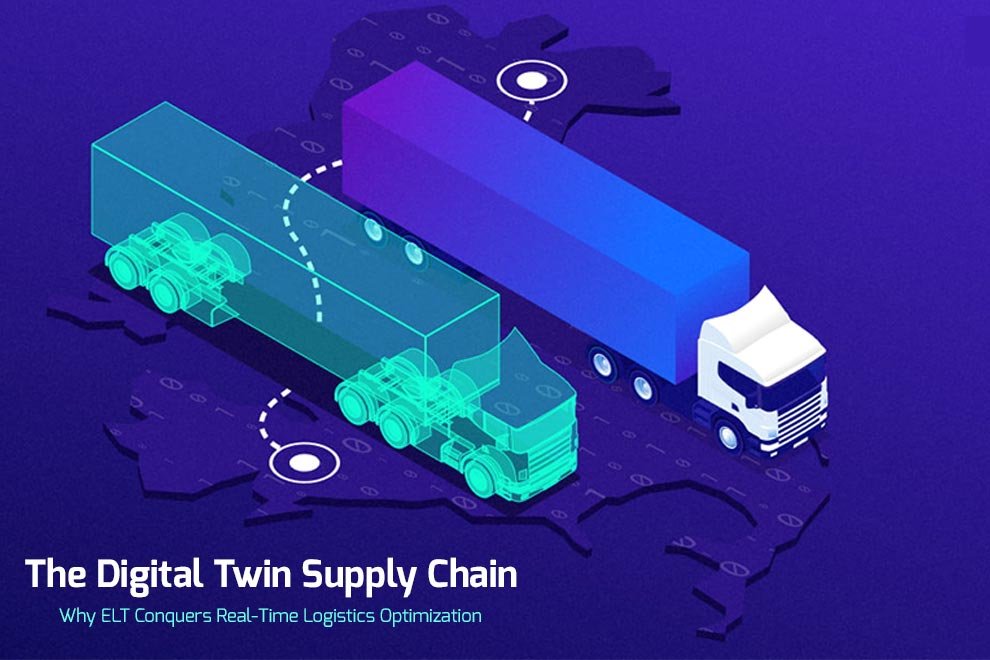Suppose you are running a huge supply chain. Trucks are waiting, warehouses getting full, and waiting customers. You have to know where everything is, what should be repaired, and how to make it go faster. That’s where the Digital Twin takes over. It builds a digital replica of your supply chain and displays everything real-time. But to make that happen, you require the appropriate method of working with data. That’s where ETL vs ELT happens.
What is a Digital Twin in the Supply Chain?
A Digital Twin is essentially a mirror for your supply chain. It collects data from sensors, machines, and systems in real-time and then maps a virtual model of your whole logistics operation. This assists companies with anticipating problems ahead of time, minimizing delays, and increasing efficiency.
For instance, picture a delivery truck full of fresh produce. A Digital Twin can monitor where it is, verify the internal temperature, and forecast potential delays. If an issue is identified, managers can respond with rapid decisions, such as a redirect of the truck or modification of storage conditions.
The Role of Data in a Digital Twin
A Digital Twin is data-driven. Each warehouse scan, GPS update, and temperature reading creates data. But if this data is to be helpful, it must be processed quickly. This is where the debate of ETL vs ELT comes into play.
ETL vs ELT: What’s the Difference?
To see why ELT is ideal for real-time logistics, let’s first dissect ETL vs ELT:
ETL (Extract, Transform, Load): Data is transformed first and then stored in a database. This is okay for standard business reports but very slow for real-time updates.
ELT (Extract, Load, Transform): Data is loaded into a database first and then transformed when required. This is a lot quicker and ideal for real-time decision making.
Why ELT Wins in Real-Time Logistics Optimization
Speed and Efficiency
ELT processes data as it arrives. As there’s no lag in converting the data initially, businesses can respond quickly. Speed is everything in logistics. Suppose a warehouse manager realizes a shipment is delayed. With ELT, they receive this information real-time and can correct the issue before it impacts customers.
Handling Large Data Volumes
Logistics firms create massive amounts of data every second. Truck GPS signals, weather forecasts, and more–everything is constantly changing. ELT enables firms to save all this data initially and analyze it whenever necessary. Such flexibility enables organizations to scale without needing to decelerate.
Improved Decision Making through Real-Time Analytics
A Digital Twin will be useful only if it gives real-time insights. With ETL, companies would need to wait for the data transformation before decision-making. ELT, however, makes raw data available immediately, enabling managers to make quicker, wiser decisions.
Cost-Effective and Cloud-Friendly
Up-to-date logistics businesses utilize cloud infrastructure. ELT performs better in the cloud environment as it enables businesses to hold raw data and process it when required. This lowers the cost of processing and enhances the performance of the system.
How ELT Empowers the Digital Twin in Real-Time Logistics
Let’s witness ETL vs ELT with a Digital Twin. Consider a pharma company shipping medicines to hospitals. Time is of the essence, and one second of delay may cost lives. Here’s how ELT helps:
Step 1: Extract Data
Truck-mounted sensors provide location, temperature, and fuel updates in real-time.
Step 2: Load Data
Data is loaded directly into the cloud without holding out for transformation.
Step 3: Transform Data
When a hospital sends a request for an update, the system automatically scans the updated data to give a correct delivery time.
This would take more time with ETL because data transformation is required before storage, which delays real-time decision-making.
Real-World Example: Smart Supply Chain of Amazon
Amazon, one of the largest supply chain giants, leverages Digital Twin technology in conjunction with ELT. It monitors millions of shipments, forecasts delays, and streamlines warehouse logistics. Without ELT, Amazon’s same-day or next-day delivery would not be possible.
The Future of Digital Twin and ELT in Logistics
As technology continues to advance, Digital Twin systems will be more intelligent. Firms will depend on machine learning and AI to anticipate disruptions before their occurrence. With ELT, organizations can process real-time data more quickly, thereby making supply chains more responsive and efficient.
Challenges of Implementing ELT in Logistics
Although ELT has numerous advantages, there are also challenges involved. Companies need to make sure they have proper cloud infrastructure to process large volumes of raw data. There is also a concern regarding security as storing raw data without transformation in advance can leave sensitive information exposed. Companies need to invest in robust cybersecurity protocols to safeguard their data.
The second one is training the employees to work on ELT-based systems in an effective way. The majority of supply chain personnel are familiar with traditional ETL processes. Making the move to ELT involves providing suitable training and assistance for smooth uptake by companies.
How to Get Started with ELT and Digital Twin
If you’re ready to leverage ELT in your logistics, here’s how you can get started:
Analyze Your Existing System: Determine which areas of pain in your supply chain can be addressed through processing real-time data.
Select Suitable ELT Tools: Most cloud-based platforms such as Google BigQuery, Snowflake, and Amazon Redshift support ELT.
Connect to Your Digital Twin: Make sure that your Digital Twin system has the capability of interfacing with your ELT platform to analyze and process real-time data.
Train Your Staff: Offer training to staff so they can leverage ELT-based analytics.
Monitor and Enhance: The system is going to be monitored on a regular basis so that it can possibly be enhanced for maximum delivery throughput.
Final Notes
Real-time data is critical in logistics. A Digital Twin allows businesses to monitor and optimise their supply chain systems, but it is associated with the required structures for processing the data. Between ETL and ELT, ELT is the clear winner regarding speed and efficiency in the processing of large amounts of data. Large corporations in the logistics industry must embrace ELT so as to keep profitable supply chains in good working order.
If your company is ready to maximize its logistics, making the move to ELT and implementing a Digital Twin is the future. The future is quick, and with ELT, your supply chain will be as well!
Also Read: Digital Twin: Definition, Working, Types, and Applications










